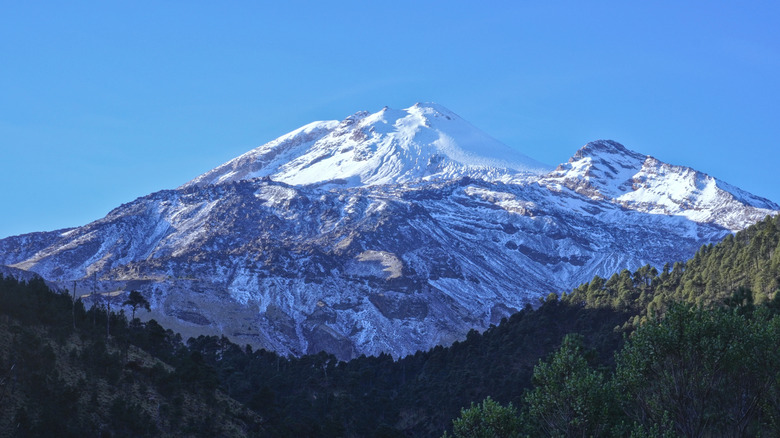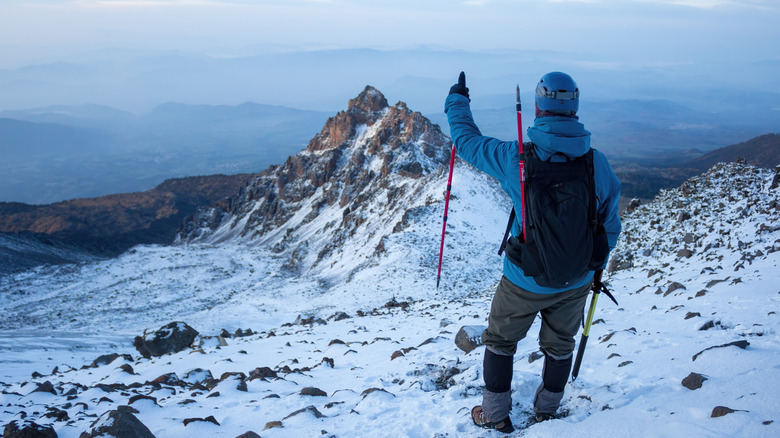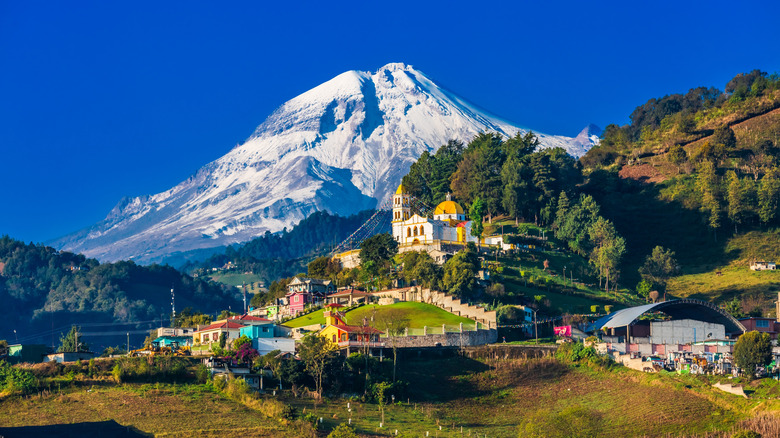Mexico's Highest Mountain Is A Perfect Peak For Beginner Mountaineers To Tackle
Towering at 18,490 feet is one of the most majestic mountains you need to see in your lifetime, Pico de Orizaba (or Citlaltépetl in the local Nahuatl language) stands tall as Mexico's highest mountain and North America's third-highest peak. Located on the border between the states of Puebla and Veracruz in central Mexico, this snow-capped volcano (depending on season) is the ideal introduction for beginners looking to venture into high-altitude mountaineering. Although challenging — because climbing an actual mountain is never a walk in the park — the peak's mostly non-technical routes make it accessible to most beginners with the right preparation.
In terms of logistics, getting to Pico de Orizaba starts with a journey to the small town of Tlachichuca — located about 140 miles outside of Mexico City, or just 65 miles from the city of Puebla. From there, you'll need 4WD transport for the final two-hour drive up a rough dirt road to reach the Refugio Piedra Grande basecamp, located at roughly 14,000 feet. To make things a little easier, most first-time (and even experienced) climbers who choose to tackle Pico de Orizaba typically reach out to local guide services — Orizaba Glacier Climbers are a popular choice, with multi-day packages available — who can provide transport, equipment, and on-the-ground expert guidance in one convenient package.
As for timing, the standard summit push begins with a midnight to 3AM start. Time-wise, it usually takes about 6-10 hours to reach the top, followed by another 3-4 hours for descent. When it comes to actual distances, though, climbers should expect a total elevation gain of approximately 4,600 feet over a 4.3-mile round trip.
The journey to the summit of Pico de Orizaba
The climb to Pico de Orizaba breaks down into three main sections. First, you'll need to follow an old aqueduct from basecamp through rocky terrain for about two hours. A welcome introduction before what's to come, this relatively straightforward section is basically a warm-up before you reach the more challenging parts of the mountain.
Then, there's "The Labyrinth" — a maze-like section of rock and ice that can get confusing to navigate, especially in the dark. Since most climbers typically reach this area around 3 or 4AM, a guide is essential to ensuring that you can make it through safely. From there, the path splits into two options: a steeper, more direct route to the right or a more gradual but longer path to the left.
Lastly, the final and most demanding section is the Jamapa Glacier, which you'll likely reach around sunrise. Here, the path angles upwards of 40 degrees, which means technical gear (crampons and an axe) is essential. Along with that, the higher altitude also makes the air noticeably thinner — which means climbers might have a harder time breathing and focusing, as well as potentially experience hallucinations. Make sure not to rush, and try to keep a slow and steady pace that'll help you save energy. Finally, just before the summit, you'll reach "Regret Rock". A rocky outcrop that signifies you're just one hour away from the summit, this last stretch continues along a soft dirt path that feels a little endless after hours of climbing. The reward, however, is (literally and figuratively) breathtaking.
Other essentials to keep in mind before tackling Orizaba
The first thing you'll need to focus on in order to succeed is proper acclimatization. Ideally, you'll want to give yourself at least 3-4 days at altitude before attempting the climb. In fact, previous climbers suggest that you warm up for Orizaba by tackling other Mexican peaks like Nevado de Toluca (15,350 feet) or La Malinche (14,640 feet). Then, once you're ready, you can make your way over to Piedra Grande basecamp by midday the day before your climb to rest up and possibly try a short acclimatization hike there.
In terms of the best gear to pack for your hike, you'll need mountaineering boots compatible with crampons and plenty of warm layers — including a base layer, mid-layer, down jacket, and waterproof shell. The summit gets seriously cold, with wind chills that can make your fingers question their life choices, so make sure you're ready to keep yourself nice and toasty. You'll also need crampons, an ice axe, and a helmet; however, if you're joining a guided excursion, it's likely these items will be provided. Additionally, don't forget a good headlamp with spare batteries (you'll be starting in the dark), quality sunglasses for glacier protection, thick gloves, a warm hat, and some high-energy snacks.
Lastly, when you climb is just as important as how you climb. Most experts agree that the best time of year to try and tackle Pico de Orizaba is between November and March, during Mexico's dry season, for the best and safest weather conditions. That said, it's always worth keeping an eye on local weather forecasts, especially considering that conditions can change very quickly at high altitude.


